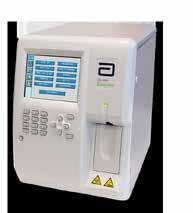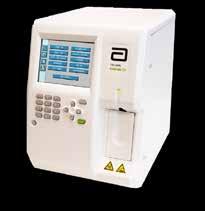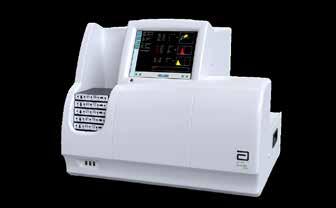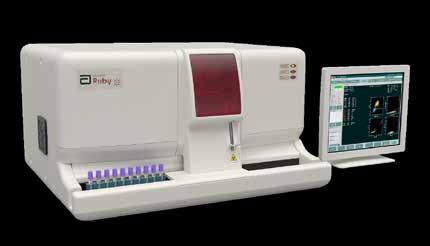




In the time it takes to send samples to a lab, you can test for multiple pathogens onsite, with results in about an hour. The bioMérieux syndromic testing approach uses multiplex PCR technology to test for a comprehensive grouping of targets, giving you accurate results, quickly. Streamline your testing to quickly provide your patients the appropriate treatment with BIOFIRE.
BIOFIRE® RESPIRATORY 2.1-EZ PANEL (EUA)*

For use with the BIOFIRE® FILMARRAY® 2.0 EZ configuration in CLIA-waived settings.
BIOFIRE® FILMARRAY® GASTROINTESTINAL PANEL**
For use in CLIA-moderate settings.
BIOFIRE® JOINT INFECTION PANEL†
For use in CLIA-moderate settings.
*This product has not been FDA cleared or approved, but has been authorized for emergency use by FDA under an EUA for use by authorized laboratories; This product has been authorized only for the detection and differentiation of nucleic acid of SARS-CoV-2 from multiple respiratory viral and bacterial organisms; and, The emergency use of this product is only authorized for the duration of the declaration that circumstances exist justifying the authorization of emergency use of in vitro diagnostics for detection and/or diagnosis of COVID-19 under Section 564(b)(1) of the Federal Food, Drug, and Cosmetic Act, 21 U.S.C. § 360bbb-3(b)(1), unless the declaration is terminated or authorization is revoked sooner. Product availability varies by country. Consult your bioMérieux
results lead to accurate treatment options, onsite in about an hour.
There are two simple ways to request information about the products and services found in Physicians Office Resource.
1. Go to www.PhysiciansOfficeResource.com and enter the four-digit reference number found next to the product or ser vice into the search field, then request additional information, schedule a demo, or speak with a sales agent all with just a simple click of a button.

2. Find the Business Reply Card in this issue, circle the desired reference numbers, complete the form, and drop into any USPS mailbox. A representative will contact you as quickly as possible to answer your questions.
www.PhysiciansOfficeResource.com
PUBLISHED BY Medical Education Resources, LLC

PUBLISHER
Aaron R. Medaris amedaris@physiciansofficeresource.com
CEO Andrew C. Nimmo acnimmo@physiciansofficeresource.com
PRESIDENT John D. Pasquale jpasquale@pharmaconnect.com
BUSINESS MANAGER Marci J. Hills mhills@physiciansofficeresource.com
TRAVEL EDITOR Brandi L. Brower
EDITORIAL BOARD
Michael Paquin, FHIMSS Barry Craig, MLT (NCA), CLC
STAFF WRITER
Dylan J. Chadwick
CREATIVE DIRECTOR PRODUCTION MANAGER Jessica Elmer
Copyright ©2022
To continue your free subscription of Physicians Office Resource magazine, please fill out the Business Reply Card (BRC) located within this magazine and drop in any United States Post Office mailbox.
If you are a manufacturer of medical products or provide services to medical professionals and would like to advertise your products or services to the nation’s top physicians doing in-office testing, call 801-380-6094 or visit: POR.io for more information.

Learn how the forthcoming generation of rapid antigen tests leverage novel technologies to allow both speed and accuracy at the nexus of action or the point of need where critical split-second medical decisions are made on PAGE 6
Each year, millions of women of all ages and backgrounds are impacted by vulvovaginal disorder, making it the main cause for health care visits by women in the United States.
For those who say “the grass isn’t always greener on the other side” my reply would have to be you haven’t been to Carton House in Maynooth Ireland.

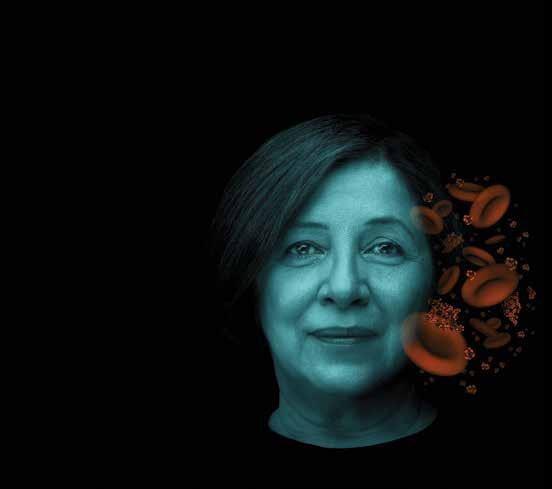
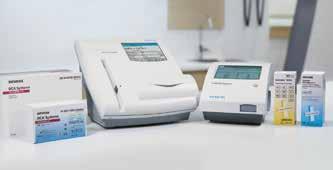


The need for increased access to immediate diagnostics and care has never been highlighted more than during the pandemic. And one by-product of the pandemic has been the rapid implementation and adoption of innovative testing technologies. These instant health care delivery tools, including next-generation rapid antigen tests have transformed the way we can deliver health care at the point of need, whether that be in hospitals, labs and importantly in community-based settings. The forthcoming generation of rapid antigen tests leverage novel technologies to allow both speed and accuracy at the nexus of action or the point of need where critical split-second medical decisions are made.
The latest point of care testing technologies not only prom ise accurate and fast results but also serve as a key compo nent in addressing testing access and inequities. The Lancet study released earlier this year “The silent and dangerous inequity around access to COVID-19 testing” explained
that POC rapid antigen tests are one of the most promising tools to increase access to testing and address the extreme inequities the pandemic exposed in testing across low- and middle-income countries (LMICs).
And, while rapid diagnostics provide an effective and scalable care delivery model at the point of need, they are also crucial for controlling future infectious outbreaks. Bill Gates, in his recent book, “How to Prevent the Next Pan demic” presents a detailed strategy on what can be done at a global scale to avoid the catastrophic impact of another pandemic. His recommended framework for pandemic prevention and response coordination specifically calls out point of care diagnostics as having untapped potential, which we can apply to disease outbreaks.
If we are to future proof our health system today, we must ensure diagnostic equity—integrating point of care diag nostics into every part of our health system—hospitals,
labs, and also pharmacies, schools, and other community settings.
Laboratory-run PCR tests are expensive, required skilled labor to perform and do not guarantee this level of effi ciency, especially for care centers in remote communities. Laboratory tests may take days to run, and the facilities are often miles away from community hospitals, not an en abling ecosystem for treatment follow through for people that travel long distances. Additionally, rapid antigen tests also circumvent the “persistent positive” results common to PCR tests, which indicate an infection for an extended period even when the person is likely no longer conta gious. Antigen tests offer an advantageous alternative, since a growing body of evidence demonstrate that antigen tests correlate more closely to culture suggesting positive results are more likely to be from active infections. In a study from a group at Johns Hopkins University (Peko sz et. al.), antigen tests demonstrated a higher positive predictive value (90%) than rt-PCR (70%) when compared to culture-positive results. Similar findings were reported by a group at Harvard (Kirby et. al), however their study design went a step further to include both lateral flow as well as microfluidic based rapid antigen test. Their findings showed enhanced sensitivity for the rapid microfluidic immunofluorescence method compared to the lateral flow antigen tests. This level of specificity empowers our ability to go back to “normal”.
The power of next generation point of care diagnostics was discussed at the recent American Association for Clinical Chemistry (AACC) Annual Conference in Chicago this summer. The discussion presented data-backed insights on the impact of LumiraDx advanced microfluidic technology over lateral flow point-of-care antigen tests, and the role of these rapid immunoassays in response to the COVID-19 pandemic.
LumiraDx, established in 2014, is transforming commu nity-based healthcare by providing fast, accurate, and comprehensive diagnostic information to healthcare pro viders at the point of need, thereby enabling better medical decisions and improved patient outcomes at a much lower cost.
As the Scientific & Clinical Affairs Vice President at Lumi raDx, I spoke alongside Dr. Paul Drain, Associate Profes sor at the University of Washington in the Departments of Global Health, Medicine (Infectious Diseases), and Epide miology at the session. Dr. Drain presented his prospective validation study of the LumiraDx severe acute respiratory syndrome coronavirus 2 (SARS-CoV-2) rapid antigen test, which uses a high-sensitivity, microfluidic immunoassay to detect the nucleocapsid protein of SARS-CoV-2 for diagnosing acute coronavirus disease 2019 (COVID-19) in adults and children across point of care settings.
The study showed that, among 512 participants, the Lu miraDx SARS-CoV-2 Ag has a 97.6% positive agreement to RT PCR in patients up to 12 days following symptom onset, and 100% PPA up to Ct 33. These findings testify to the effectiveness of rapid, high-sensitivity assay using naso pharyngeal or anterior nasal sampling, offering significant improvements for diagnosing acute SARS-CoV-2 infection in clinic- and community-based settings. Dr. Drain also shared more recent data showing that differences between Delta and Omicron variants did not affect the performance of the LumiraDx SARS-CoV-2 Antigen Test
As we look ahead, immediacy is central to meeting patient care needs and optimizing provider decision making. Giv en the looming challenges of future pandemics, we should support policies that invest in integrated, scalable diag nostic solutions, which we can deploy rapidly at the point of care, especially in communities where little healthcare infrastructure is present. This will enable effective deci sion-making at the point of need, increase access to care, save health care costs, and improve patient outcomes.
Brian K. DuChateau, Ph.D., D(ABMLI) is a board cer tified clinical laboratory immunologist who received his Ph.D. in immunology and medical microbiology from the University of Wisconsin-Madison and completed a post-doc toral residency in clinical immunology at the Chicago Med ical School. Dr. DuChateau has over 20 years of experience as a clinical laboratory director and 12 years of in vitro diag nostics (IVD) experience and currently serves as the Lumi raDx Vice President of US Scientific and Clinical Affairs.
The latest point of care testing technologies not only promise accurate and fast results but also serve as a key component in addressing testing access and inequities.
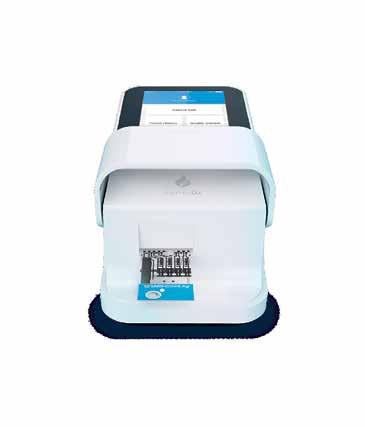
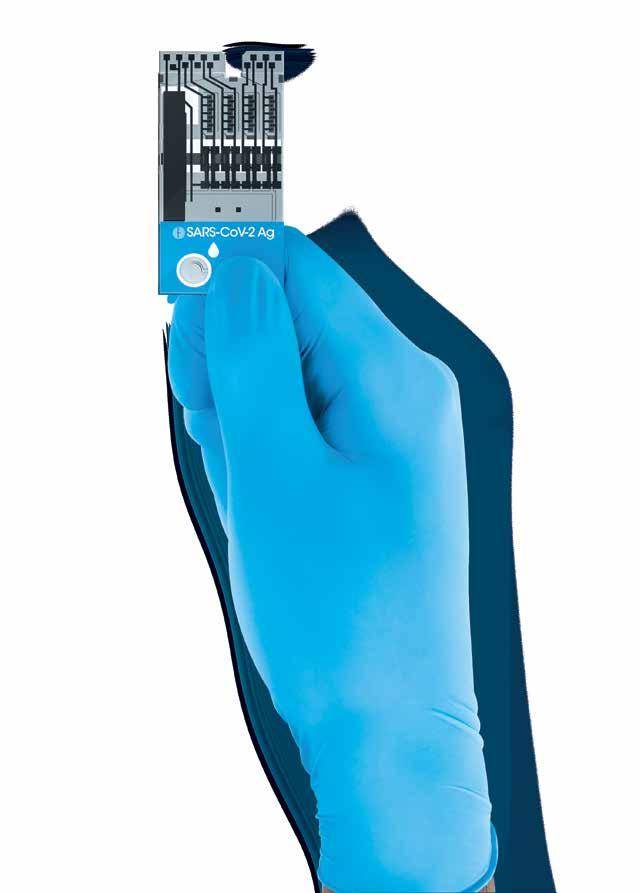
From
When upgrading or starting a lab, look no further. With a moderately complex menu of 35 general chemistry and 14 urine drug screens, the EasyRA is well-suited for oncology, rheumatology, and multi-specialty practic es needing a high-speed benchtop clinical chemistry analyzer. The EasyRA® offers photometric throughput of 240+ tests/hr (up to 480 tests/hr with ISE) and STAT samples in under 8 minutes. This all-in-one system is easy to learn and easy to operate.


View Brochures, Videos & More at POR.io Enter Number 2106 in the Search Area
One benchtop, not a whole lab! No water system, drain or special electrical connected required to operate the Pentra C400 chemistry analyzer. Now you can have the power of a floor model analyzer on the benchtop! The Pentra C400 chemistry system processes up to 420 tests/hr including ISEs and offers routine metabolic assays, TDMs, DAUs and Adulterants, HbA1c and Vitamin D tests. With 40 open channels, you can add much more for a complete menu to meet your practice needs.
View Brochures, Videos & More at POR.io Enter Number 2107 in the Search Area 2107
From LumiraDx
Introducing the next generation in point-of-care diagnostics. With a growing menu of tests, LumiraDx uses a simple process that allows for more time with your patients by using microfluidic technology that delivers results in minutes. Learn more about rapid COVID-19 diagnostic solutions for your physician office at LumiraDx.com.
View Brochures, Videos & More at POR.io Enter Number 2108 in the Search Area
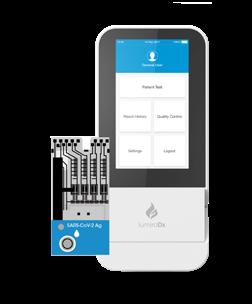



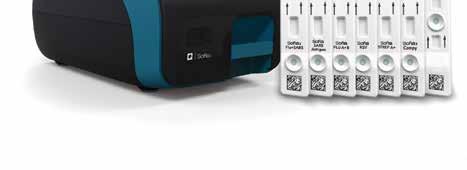



Each year, millions of women of all ages and backgrounds are impacted by vulvovaginal disorder, making it the main cause for health care visits by women in the United States.1 This disorder usually occurs due to an infection or when the bacterium in the vagina becomes unbalanced. Two common causes of vulvovaginal disorder are Bacterial vagi nosis and Trichomoniasis.
Bacterial vaginosis and Trichomoniasis are linked to a broad range of associated health complications, from preterm birth to an increase in Sexually Transmitted Infections (STIs).2,3 If immediately diagnosed and treated, the risk of associated health complications can be greatly minimized. Therefore, a “test and treat” approach is critical to take when diagnosing Bacterial vaginosis and Trichomo niasis. Key considerations on different diagnostic methods for Bacterial vaginosis and Trichomoniasis will be reviewed in this editorial.
Bacterial vaginosis occurs when the healthy balance of vaginal bacteria is disrupted by an overgrowth of pathogen ic bacteria. It is the most prevalent form of all vulvovaginal disorder, resulting up to 50% of all cases.1
Common symptoms of Bacterial vaginosis consist of the following:2
• A thin white or gray vaginal discharge
• Pain, itching, or burning in the vagina
• A strong fish-like odor, especially after sex
• Burning when urinating
• Itching around the outside of the vagina
There are serious health complications associated with Bac terial vaginosis, including the increased risk of contracting several different STIs. Therefore, all women suspected of having Bacterial vaginosis should be evaluated for Human Immunodeficiency Virus (HIV) and other STIs.1
Common diagnostic methods for Bacterial vaginosis con sists of Nugent scoring from a vaginal Gram stain, Amsel’s Criteria, molecular tests, and rapid point-of-care tests.4
Nugent scoring from a vaginal Gram stain is considered the gold standard for diagnosing Bacterial vaginosis.4 It consists of performing a Gram stain where the vaginal specimen is smeared on a glass slide. Then the vaginal smear is evaluated under a microscope according to the Nugent scoring system. The Nugent score is calculated by assessing for the presence of large gram-positive rods (Lactobacillus morphotypes; decrease in Lactobacillus scored as 0 to 4), small gram-variable and gram-negative rods (G. vaginalis and Bacteroides morphotypes; scored as 0 to 4), and curved gram-variable rods (Mobiluncus spp. morphotypes; scored as 0 to 2).4 Although considered the gold standard, there are challenges associated with Nugent scoring from a vaginal Gram stain. For example, a Gram stain is a multistep process that requires significant handson activities and is usually performed in a laboratory setting. Also, it is a very complex procedure that requires a specific skillset to perform. Due to the significant hands-on activities of the process and the complexity of the proce dure, Nugent scoring from a vaginal Gram stain does not allow for a test and treat approach.
Amsel’s Criteria is a traditional diagnostic method based on microscopy and clinical symptoms. The method is based on the presence of 3 of the following criteria:4
1. Discharge: homogeneous, thin, white-gray discharge that smoothly coats the vaginal walls
2. Clue cells: more than 20% clue cells on saline microscopy
3. pH >4.5: vaginal fluid pH >4.5
4. Positive KOH: positive KOH whiff test result
Diagnosing Bacterial vaginosis by Amsel’s Criteria can be time consuming and it is prone to subjectivity as there are multiple steps involved. Amsel’s Criteria is considered a Provider-Performed Microscopy (PPM) procedure, which is a complex procedure that limits the testing to only physicians or mid-level providers. Due to the multiple steps of the process and the complexity of the procedure, Amsel’s Criteria usually does not allow for a test and treat approach.
There are different molecular tests available for diagnosing Bacterial vaginosis, which detect specific bacterial nucleic
acids. The sensitivity and specificity of these tests are high, allowing for accurate test results. However, the methodolo gy requires highly expensive and sophisticated instrumen tation that require a specialized skillset to perform, making it hard for health care providers to adopt the technology into their practice.
The Centers for Disease Control and Prevention (CDC) notes the OSOM® BVBLUE® test in their 2021 Sexually Transmitted Infections Treatment Guidelines as a recom mended rapid point-of-care test for diagnosing Bacterial vaginosis.4 Unlike Nugent scoring from a vaginal Gram stain and Amsel’s Criteria, the OSOM® BVBLUE® Test is CLIA-waived and does not require a specific skillset. Also, unlike molecular tests, the OSOM® BVBLUE® Test does not require specialized instrumentation to perform. It is a vi sual read, enzymatic activity assay that detects the sialidase enzyme of bacterial pathogens. The test can be performed at the point-of-care and the results are produced in 10 minutes, allowing for a test and treat approach.
Trichomoniasis is a parasitic infection caused by a proto zoan parasite called Trichomonas vaginalis. It is considered the most curable, non-viral sextually transmitted disease, with an estimated 3.7 million cases per year in the United States.6 It is estimated that up to 35% of all vulvovaginal disorders are caused by Trichomonas vaginalis.1
Common symptoms of Bacterial vaginosis consist of the following:3
• A thin clear, white, yellowish, or greenish vaginal discharge
• Itching, burning, redness or soreness of the vagina
• An unusual fishy smell
• Discomfort with urination
The health complications associated with Trichomoniasis consists of an increased risk of getting or spreading other STIs, a greater chance of preterm birth, an increased risk of cervical cancer.3
Common diagnostic methods for diagnosing Trichomoni asis consists of wet-mount microscopy, culture followed by wet-mount microscopy, molecular tests, and rapid pointof-care tests.5
Wet-mount microscopy has traditionally been used to di agnose Trichomoniasis. The method consists of collecting a vaginal specimen and examining it for motile organisms, called trichomonads, under a microscope. It is important to note that the specimen should be immediately examined after collection as 20% of trichomonads lose their motility within 10 minutes of specimen collection.7 Wet-mount microscopy is a relatively inexpensive method and can be performed at the point-of-care. However, the sensitivity can be relatively low, leading to an increase in false nega tive tests results.5
Culture followed by wet-mount microscopy is a more
sensitive test method than wet-mount microscopy.5 Prior to examining the specimen under a microscope for tricho monads, the specimen is inoculated and incubated for 2-5 days. The primary challenge with this method is the time it takes to incubate the specimen, resulting in a disrupted quality of life for the patient.
Molecular tests are considered the gold standard for diagnosing Trichomoniasis. These are highly sensitive tests that detect the genetic material of the parasite, called Trichomonas vaginalis. Although these tests are highly accurate, they require highly expensive and sophisticated instrumentation that usually require a specialized skillset to perform, making it hard for health care providers to adopt the technology into their practice.
The CDC notes the OSOM® Trichomonas Test in their 2021 Sexually Transmitted Infections Treatment Guide lines as a recommended rapid point-of-care test for diagnosing Trichomonas.5 The OSOM® Trichomonas Test is a visual read, lateral flow antigen test that detects the protein of trichomonas called Trichomonas vaginalis. It is a CLIA-waived test that can be performed at the point-ofcare, allowing for a test and treat approach. The sensitivity of the OSOM® Trichomonas Test compares favorably to the molecular tests with reported sensitivities of 83%-90%.6
Vulvovaginal disorder is a common condition that can drastically impact the quality of life for women. It is a disorder that is responsible for 10 million physician visits per year.1 Bacterial vaginosis and Trichomoniasis are two common causes of vulvovaginal disorder, which both have a mix of symptoms and associated health complica tions. To overcome the disrupted quality of life for women and the associated health complications, a test and treat approach should be taken when diagnosing Bacterial vaginosis and Trichomoniasis. The CDC notes the OSOM® BVBLUE® Test and the OSOM® Trichomonas Test in their 2021 Sexually Transmitted Infections Treatment Guide lines as diagnostic considerations for Bacterial vaginosis and Trichomoniasis. Both tests have high sensitivity and specificity compared to the gold standard methods and allow for a test and treat approach.
1. Brown, H. Improving the Diagnosis of Vulvovaginitis. Population Health Management. Vol. 23, suppl 1, 2020.
2. CDC. Fact Sheet - Bacterial Vaginosis. 2017
3. CDC. Fact Sheet - Trichomoniasis. 2017
4. CDC. Sexually Transmitted Infections Treatment Guidelines, Bacterial Vaginosis. 2021
5. CDC. Sexually Transmitted Infections Treatment Guidelines, Trichomoniasis. 2021
6. Gaydo. C. Rapid and Point-of-Care Tests for the diagnosis of Trichomonas vaginalis in women and men. Sex Trans Infect. 2017.
7. Kingston MA, Bansal D, Carlin EM. ‘Shelf life’ of Trichomonas vaginalis. Int J STD AIDS. 2003 Jan;14(1)
We understand it is crucial to immediately diagnose and treat vulvovaginal disorders which are linked to a broad range of associated health complications, from preterm birth to an increase in Sexually Transmitted Infections.1

The OSOM® BVBLUE® and OSOM® Trichomonas Tests are easy-to-use, CLIA-waived and produce accurate and objective results for two of the most common causes of vulvovaginal disorders so you can get the answers fast and your patients back to doing what they love.

Like you, we understand there is a patient behind every answer—and that’s what matters most.
For more information, call 800-332-1042, or visit us at osomtests.com
From
The BIOFIRE® 2.0 EZ Configuration facilitates rapid, near-patient molecular diagnostic testing. It is designed to be used with a BIOFIRE respiratory diagnostic solution in CLIA-waived testing sites, including clinics and physician offices. The system enables decentralized molecular testing throughout a provider network and features a simplified and intuitive interface. The BIOFIRE 2.0 EZ Configuration accurately provides results in about 45 minutes with only two minutes of hands-on time.
View Brochures, Videos & More at POR.io Enter Number 2112 in the Search Area
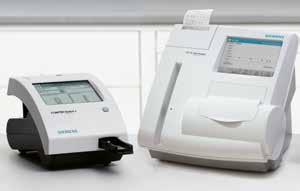


2112 2113
From Quidel
Sofia® 2 Fluorescent Immunoassay Analyzer and Rapid Diagnostic Test Kits Sofia 2 takes rapid testing to a new level. Proven lateral-flow technology and advanced fluorescent chemistry are all integrated into this small benchtop analyzer which can be used in any point-of-care setting. Sofia 2 kits are easy to use and adaptable to any healthcare setting. Excellent performance, objectivity, quality control, LIS capabilities, and an expanding test menu make Sofia 2 the perfect solution for the physician’s office laboratory.
View Brochures, Videos & More at POR.io Enter Number 2113 in the Search Area
From
Siemens Healthineers DCA Vantage® and CLINITEK Status® family of analyzers provide hemoglobin A1c (HbA1c) and albuminto-creatinine ratio (ACR) testing at the point of care. Meet quality measures for A1c control and kidney disease check in minutes with CLIA-waived HbA1c testing and ACR1 ratio. Improve patient
1. Moderately complex on the DCA Vantage Analyzer. CLIA-waived on the CLINITEK Status+ Analyzer.
View Brochures, Videos & More at POR.io Enter Number 2114 in the Search Area



2115
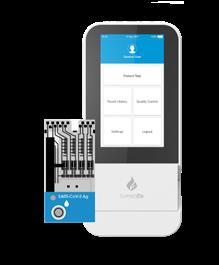

From Nova Biomedical
The U.S. FDA has cleared Nova Primary as a blood glucose reference analyzer that fills the need for a new reference analyzer to replace the YSI STAT PLUS 2300 (YSI, Inc., Yellow Springs, OH). Manufacturers of blood glucose measuring devices and clinical diabetes researchers have relied on the YSI 2300 as a reference and correlation analyzer. However, YSI, Inc. no longer supports the analyzer, and its discontinuation has left a critical industry void. With today’s FDA clearance, Nova Primary from Nova Biomedical is now available in the U.S. and worldwide.
View Brochures, Videos & More at POR.io Enter Number 2115 in the Search Area
The Acucy™ Influenza A&B Test is for the rapid, qualitative detection of influenza A and B viral nucleoprotein antigens from both nasal and nasopharyngeal swabs. Utilizing the Acucy™ Reader in either the point-of-care or laboratory setting, workflow flexibility is achieved with both Read Now and Walk Away features. The combination provides clinicians with standardized and definitive result interpretation.
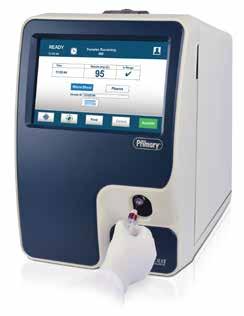
View Brochures, Videos & More at POR.io Enter Number 2116 in the Search Area 2116
2117
ARE NOW DELIVERED AT THE POINT OF CARE. From LumiraDx
Introducing the next generation in point-of-care diagnostics. With a growing menu of tests, LumiraDx uses a simple process that allows for more time with your patients by using microfluidic technology that delivers results in minutes. Learn more about rapid COVID-19 diagnostic solutions for your physician office at LumiraDx.com.
View Brochures, Videos & More at POR.io Enter Number 2117 in the Search Area
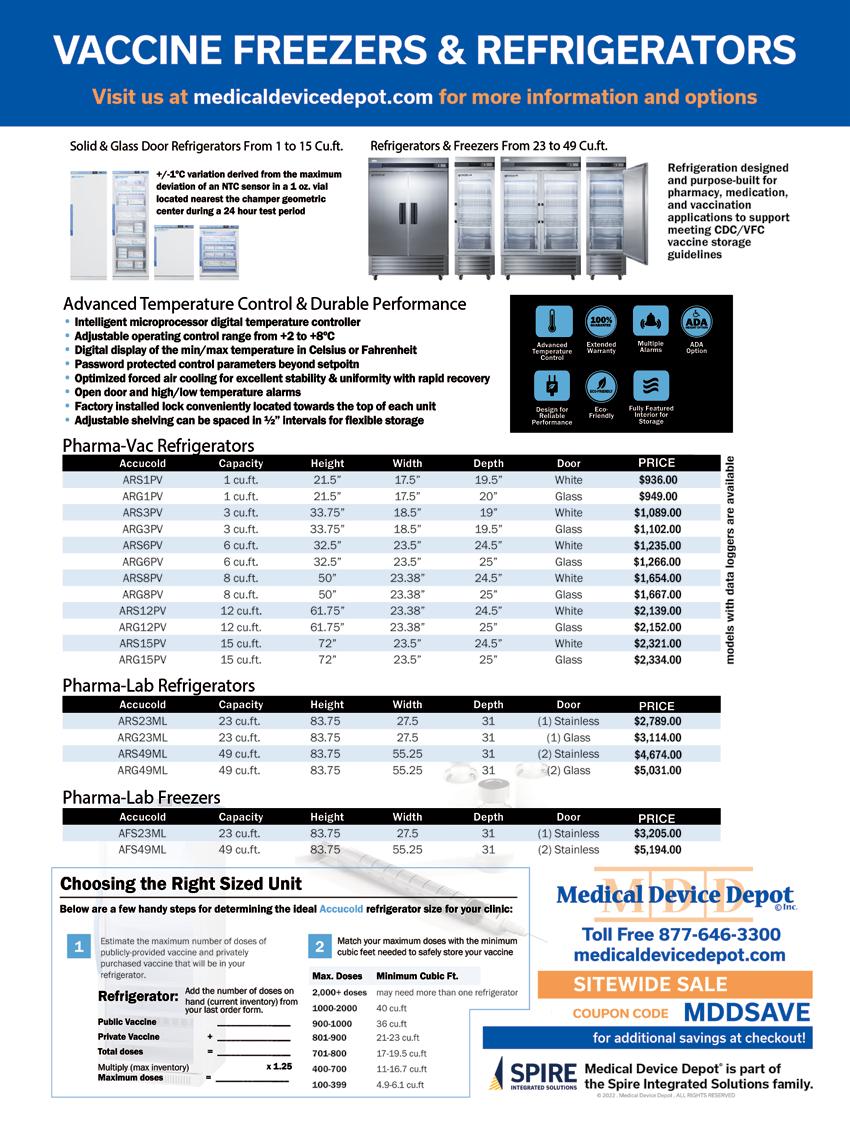
2119
From
Stronger Clinical Performance Takes Lateral Flow Testing To The Next Level. Providing superior rapid results at the point-of-care. Fast, easy, cost effective so you can test and treat in one visit.
• High Performance- Equivalent or exceeding the performance of reader devices, without the need for an instrument
• Results in 10 minutes
• OSOM® Custom Care- Exceptional Support/Training by licensed medical technologists and experienced healthcare professionals
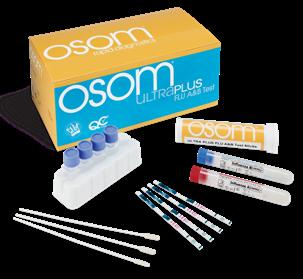
• Made in the USA
View Brochures, Videos & More at POR.io
Enter Number 2119 in the Search Area

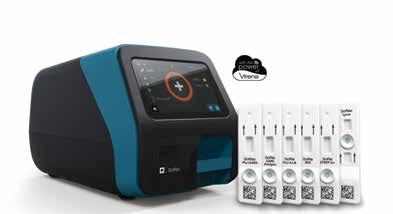
From Quidel
Sofia® 2 Fluorescent Immunoassay Analyzer and Rapid Diagnostic Test Kits Sofia 2 takes rapid testing to a new level. Proven lateral-flow technology and advanced fluorescent chemistry are all integrated into this small benchtop analyzer which can be used in any point-of-care setting. Sofia 2 kits are easy to use and adaptable to any healthcare setting. Excellent performance, objectivity, quality control, LIS capabilities, and an expanding test menu make Sofia 2 the perfect solution for the physician’s office laboratory.
View Brochures, Videos & More at POR.io
2121
2120
FIRST EVER CLIA WAIVED HEMATOLOGY ANALYZER

View Brochures, Videos & Mores at POR.io
Enter Number 2121 in the Search Area

2128

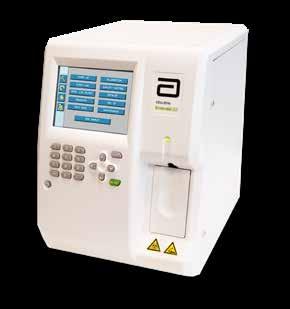
CELL-DYN
From Abbott
The CELL-DYN Emerald 22 is a full performance 5-part hematology analyzer for smaller clinical laboratories seeking productivity in smaller spaces.
Benefits:
• Compact Design - To conserve valuable workspace.
• Small and Powerful - Includes a numeric keypad entry, reagent tray, and integrated color touchscreen monitor.
• Easy and Automated - Barcoded reagents and touch-free scheduled daily maintenance, startup and shutdown.
• Online product training - Self-pace training available 24x7 on the Abbott’s Hematology Academy.
View Brochures, Videos & More at POR.io Enter Number 2128 in the Search Area
From HORIBA
Is it viral or bacterial? A CBC with 3-part differential can provide the clues to help distinguish between viral and bacterial infections before you decide to treat. The Micros 60 Hematology analyzer provides a CBC with 3-part Diff result in less than 60 seconds using only 10 µL of sample. Connect to the LiteDM Patient Data Management System for an affordable way to consolidate patient results to one report.
View Brochures, Videos & More at POR.io Enter Number 2129 in the Search Area
2130
2129
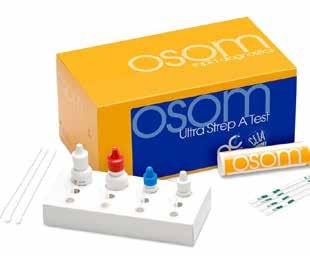
The OSOM® Ultra Strep A test is a color immunochro matographic assay intended for the qualitative detection of Group A Streptococcus antigen directly from throat swab specimens. Shown to be not statistically different than single swab culture. Sensitivity 95.7% and 100% Specificity. Includes two additional test sticks for External QC. CLIA Waived..
View Brochures, Videos & More at POR.io Enter Number 2130 in the Search Area


INVEGA HAFYERA™, an every-six-month injection, is an atypical antipsychotic indicated for the treatment of schizophrenia in adults after they have been adequately treated with:
• A once-a-month paliperidone palmitate extended release injectable suspension (e.g., INVEGA SUSTENNA®) for at least four months or
• An every-three-month paliperidone palmitate extended release injectable suspension (e.g., INVEGA TRINZA®) for at least one three-month cycle.
WARNING: INCREASED MORTALITY IN ELDERLY PATIENTS WITH DEMENTIA-RELATED PSYCHOSIS. See full prescribing information for complete Boxed Warning.
Elderly patients with dementia-related psychosis treated with antipsychotic drugs are at an increased risk of death. INVEGA HAFYERA™ is not approved for use in patients with dementia-related psychosis.
Contraindications: INVEGA HAFYERA™ is contraindicated in patients with a known hypersensitivity to either paliperidone, risperidone, or to any excipients of their formulation.
Cerebrovascular Adverse Reactions: Cerebrovascular adverse reactions (e.g., stroke, transient ischemic attacks), including fatalities, were reported at a higher incidence in elderly patients with dementia-related psychosis taking risperidone, aripiprazole, and olanzapine compared to placebo. No studies have been conducted with oral paliperidone or INVEGA HAFYERA™ in elderly patients with dementia. These medications are not approved for the treatment of patients with dementia-related psychosis.
Neuroleptic Malignant Syndrome (NMS): NMS, a potentially fatal symptom complex, has been reported in association with antipsychotic drugs, including paliperidone.
Clinical manifestations of NMS are hyperpyrexia, muscle rigidity, altered mental status including delirium, and autonomic instability (irregular pulse of blood pressure, tachycardia, diaphoresis, and cardiac dysrhythmia). Additional signs may include elevated creatine phosphokinase, myoglobinuria (rhabdomyolysis), and acute renal failure.
If NMS is suspected, immediately discontinue INVEGA HAFYERA™ and provide symptomatic treatment and monitoring.
QT Prolongation: Paliperidone causes a modest increase in the corrected QT (QTc) interval. Avoid the use of drugs that also increase QTc interval and in patients with risk factors for prolonged QTc interval. Paliperidone should also be avoided in patients with congenital long QT syndrome and in patients with a history of cardiac arrhythmias. Certain circumstances may increase the risk of the occurrence of torsades de pointes and/or sudden death in association with the use of drugs that prolong the QTc interval.
Tardive Dyskinesia (TD): TD, a syndrome consisting of potentially irreversible, involuntary, dyskinetic movements, may develop in patients treated with antipsychotic drugs. Although the prevalence of the syndrome appears to be highest among the elderly, especially elderly women, it is impossible to predict which patients will develop the syndrome. Whether antipsychotic drug products differ in their potential to cause tardive dyskinesia is unknown.
The risk of developing TD and the likelihood that it will become irreversible appear to increase with the duration of treatment and the cumulative dose. The syndrome can develop after relatively brief treatment periods, even at low doses. It may also occur after discontinuation. TD may remit, partially or completely, if antipsychotic treatment is discontinued. Antipsychotic treatment itself, however, may suppress (or partially suppress) the signs and symptoms of the syndrome, possibly masking the underlying process. The effect that symptomatic suppression has upon the long-term course of the syndrome is unknown.
If signs and symptoms of TD appear in a patient on INVEGA HAFYERA™, drug discontinuation should be considered. However, some patients may require treatment with INVEGA HAFYERA™ despite the presence of the syndrome. In patients who do require chronic treatment, use the lowest dose and the shortest duration of treatment producing a satisfactory clinical response. Periodically reassess the need for continued treatment.
Metabolic Changes: Atypical antipsychotic drugs have been associated with metabolic changes that may increase cardiovascular/cerebrovascular risk. These metabolic changes include hyperglycemia, dyslipidemia, and body weight gain. While all of the drugs in the class have been shown to produce some metabolic changes, each drug has its own specific risk profile.
Hyperglycemia and Diabetes Mellitus: Hyperglycemia and diabetes mellitus, in some cases extreme and associated with ketoacidosis, hyperosmolar coma or death, have been reported in patients treated with all atypical antipsychotics (APS). Patients starting treatment with APS who have or are at risk for diabetes mellitus should undergo fasting blood glucose testing at the beginning of and during treatment. Patients who develop symptoms of hyperglycemia during treatment should also undergo fasting blood glucose testing. All patients treated with atypical antipsychotics should be monitored for symptoms of hyperglycemia. Some patients require continuation of antidiabetic treatment despite discontinuation of the suspect drug. Dyslipidemia: Undesirable alterations have been observed in patients treated with atypical antipsychotics.
Weight Gain: Weight gain has been observed with atypical antipsychotic use. Clinical monitoring of weight is recommended.
Orthostatic Hypotension and Syncope: INVEGA HAFYERA™ may induce orthostatic hypotension in some patients due to its alpha-adrenergic blocking activity. INVEGA HAFYERA™ should be used with caution in patients with known cardiovascular disease, cerebrovascular disease or conditions that would predispose patients to hypotension (e.g., dehydration, hypovolemia, treatment with antihypertensive medications). Monitoring should be considered in patients for whom this may be of concern.
Falls: Somnolence, postural hypotension, motor and sensory instability have been reported with the use of antipsychotics, including INVEGA HAFYERA™, which may lead to falls and, consequently, fractures or other fall-related injuries. For patients, particularly the elderly, with diseases, conditions, or medications that could exacerbate these effects, assess the risk of falls when initiating antipsychotic treatment and recurrently for patients on long-term antipsychotic therapy.
Leukopenia, Neutropenia and Agranulocytosis have been reported with antipsychotics, including INVEGA HAFYERA™. In patients with a history of clinically significant low white blood cell count (WBC)/absolute neutrophil count (ANC) or drug-induced leukopenia/neutropenia, perform a complete blood count frequently during the first few months of therapy. Consider discontinuing INVEGA HAFYERA™ at the first sign of a clinically significant decline in WBC in the absence of other causative factors. Monitor patients with clinically significant neutropenia for fever or other symptoms or signs of infection and treat promptly if such symptoms or signs occur. Discontinue INVEGA HAFYERA™ in patients with severe neutropenia (absolute neutrophil count <1000/mm3) and follow their WBC until recovery.
Hyperprolactinemia: As with other drugs that antagonize dopamine D 2 receptors, INVEGA HAFYERA™ elevate prolactin levels, and the elevation persists during chronic administration. Paliperidone has a prolactin-elevating effect similar to risperidone, which is associated with higher levels of prolactin elevation than other antipsychotic agents.
Potential for Cognitive and Motor Impairment: Somnolence, sedation, and dizziness were reported as adverse reactions in subjects treated with INVEGA HAFYERA™. INVEGA HAFYERA™ has the potential to impair judgment, thinking, or motor skills. Patients should be cautioned about performing activities that require mental alertness such as operating hazardous machinery, including motor vehicles, until they are reasonably certain that INVEGA HAFYERA™ does not adversely affect them.
Seizures: INVEGA HAFYERA™ should be used cautiously in patients with a history of seizures or with conditions that potentially lower seizure threshold. Conditions that lower seizure threshold may be more prevalent in patients 65 years or older.
Administration: For gluteal intramuscular injection only by a healthcare professional using only the needles provided in the INVEGA HAFYERA™ kits. Care should be taken to avoid inadvertent injection into a blood vessel.
Drug Interactions: Strong CYP3A4/P-glycoprotein (P-gp) inducers: Avoid using a strong inducer of CYP3A4 and/or P-gp (e.g., carbamazepine, rifampin, St John’s Wort) during a dosing interval for INVEGA HAFYERA™. If administering a strong inducer is necessary, consider managing the patient using paliperidone extended-release tablets.
Pregnancy/Nursing: INVEGA HAFYERA™ may cause extrapyramidal and/or withdrawal symptoms in neonates with third trimester exposure. Advise patients to notify their healthcare professional if they become pregnant or intend to become pregnant during treatment with INVEGA HAFYERA™. Patients should be advised that there is a pregnancy registry that monitors outcomes in women exposed to INVEGA HAFYERA™ during pregnancy. INVEGA HAFYERA™ can pass into human breast milk. The benefits of breastfeeding should be considered along with the mother’s clinical need for INVEGA HAFYERA™ and any potential adverse effect on the breastfed infant from INVEGA HAFYERA™ or the mother’s underlying condition.
Commonly Observed Adverse Reactions for INVEGA HAFYERA™: The most common adverse reactions (incidence at least 5% in the double-blind phase) in the INVEGA HAFYERA™ clinical trial were upper respiratory tract infection, injection site reaction, weight increased, headache and parkinsonism.

Before prescribing INVEGA HAFYERA™, please review the full Prescribing Information, including Boxed WARNING, available at www.InvegaHafyerahcp.com. Please see Brief Summary of full Prescribing Information on following pages of this advertisement. cp-256050v1
REFERENCE: 1. INVEGA HAFYERA™ [Prescribing Information]. Titusville, NJ: Janssen Pharmaceuticals, Inc.; August 2021. © Janssen Pharmaceuticals, Inc. 2022 03/22 cp-301733v1
(paliperidone palmitate) extended-release injectable suspension, for gluteal intramuscular use
Brief Summary
BEFORE PRESCRIBING INVEGA HAFYERA™, PLEASE SEE FULL PRESCRIBING INFORMATION, INCLUDING BOXED WARNING.
WARNING: INCREASED MORTALITY IN ELDERLY PATIENTS WITH DEMENTIA-RELATED PSYCHOSIS
Elderly patients with dementia-related psychosis treated with antipsychotic drugs are at an increased risk of death. INVEGA HAFYERA is not approved for use in patients with dementia-related psychosis [see Warnings and Precautions].
INVEGA HAFYERA, an every-six-month injection, is indicated for the treatment of schizophrenia in adults after they have been adequately treated with:
• A once-a-month paliperidone palmitate extended-release injectable suspension (e.g., INVEGA SUSTENNA) for at least four months, or
• An every-three-month paliperidone palmitate extended-release injectable suspension (e.g., INVEGA TRINZA) for at least one three-month cycle.
INVEGA HAFYERA is contraindicated in patients with a known hypersensitivity to either paliperidone or risperidone, or to any of the excipients in the INVEGA HAFYERA formulation. Hypersensitivity reactions, including anaphylactic reactions and angioedema, have been reported in patients treated with risperidone and in patients treated with paliperidone. Paliperidone palmitate is converted to paliperidone, which is a metabolite of risperidone.
Increased Mortality in Elderly Patients with Dementia-Related Psychosis Elderly patients with dementia-related psychosis treated with antipsychotic drugs are at an increased risk of death. Analyses of 17 placebo-controlled trials (modal duration of 10 weeks), largely in patients taking atypical antipsychotic drugs, revealed a risk of death in drug-treated patients of between 1.6 to 1.7 times the risk of death in placebo-treated patients. Over the course of a typical 10-week controlled trial, the rate of death in drug-treated patients was about 4.5%, compared to a rate of about 2.6% in the placebo group. Although the causes of death were varied, most of the deaths appeared to be either cardiovascular (e.g., heart failure, sudden death) or infectious (e.g., pneumonia) in nature. Observational studies suggest that, similar to atypical antipsychotic drugs, treatment with conventional antipsychotic drugs may increase mortality. The extent to which the findings of increased mortality in observational studies may be attributed to the antipsychotic drug as opposed to some characteristic(s) of the patients is not clear. INVEGA HAFYERA is not approved for the treatment of patients with dementia-related psychosis [see Boxed Warning and Warnings and Precautions].
Cerebrovascular Adverse Reactions, Including Stroke, in Elderly Patients with Dementia-Related Psychosis
In placebo-controlled trials with risperidone, aripiprazole, and olanzapine in elderly subjects with dementia, there was a higher incidence of cerebrovascular adverse reactions (cerebrovascular accidents and transient ischemic attacks) including fatalities compared to placebo-treated subjects. No studies have been conducted with oral paliperidone, the 1-month paliperidone palmitate extended-release injectable suspension, the 3-month paliperidone extended-release injectable suspension or INVEGA HAFYERA in elderly patients with dementia. These medications are not approved for the treatment of patients with dementia-related psychosis [see Boxed Warning and Warnings and Precautions].
Neuroleptic Malignant Syndrome (NMS), a potentially fatal symptom complex, has been reported in association with antipsychotic drugs, including paliperidone.
Clinical manifestations of NMS are hyperpyrexia, muscle rigidity, altered mental status, including delirium, and autonomic instability (irregular pulse or blood pressure, tachycardia, diaphoresis, and cardiac dysrhythmia). Additional signs may include elevated creatine phosphokinase, myoglobinuria (rhabdomyolysis), and acute renal failure.
If NMS is suspected, discontinue INVEGA HAFYERA and provide symptomatic treatment and monitoring.
Paliperidone causes a modest increase in the corrected QT (QTc) interval. The use of paliperidone should be avoided in combination with other drugs that are known to prolong QTc including Class 1A (e.g., quinidine, procainamide) or Class III (e.g., amiodarone, sotalol) antiarrhythmic medications, antipsychotic medications (e.g., chlorpromazine, thioridazine), antibiotics (e.g., gatifloxacin, moxifloxacin), or any other class of medications known to prolong the QTc interval. Paliperidone should also be avoided in patients with congenital long QT syndrome and in patients with a history of cardiac arrhythmias. Certain circumstances may increase the risk of the occurrence of Torsades de pointes and/or sudden death in association with the use of drugs that prolong the QTc interval, including (1) bradycardia; (2) hypokalemia or hypomagnesemia; (3) concomitant use of other drugs that prolong the QTc interval; and (4) presence of congenital prolongation of the QT interval.
INVEGA HAFYERA™ (paliperidone palmitate)The effects of paliperidone on the QT interval were evaluated in a doubleblind, active-controlled (moxifloxacin 400 mg single dose), multicenter Thorough QT study with oral paliperidone in adult patients, and in four fixeddose efficacy studies and one maintenance study of the 1-month paliperidone palmitate injectable product.
In the Thorough QT study (n=141), the 8 mg dose of immediate-release oral paliperidone (n=50) showed a mean placebo-subtracted increase from baseline in QTcLD (QT interval corrected for heart rate using the population specified linear derived method) of 12.3 msec (90% CI: 8.9; 15.6) on day 8 at 1.5 hours post-dose. The mean steady-state peak plasma concentration for this 8 mg dose of paliperidone immediate release (Cmax ss=113 ng/mL) was approximately 1.3-fold the exposure with the maximum recommended 1,560 mg dose of INVEGA HAFYERA administered in the gluteal muscle (mean Cmax md=89.3 ng/mL). In this same study, a 4 mg dose of the immediate-release oral formulation of paliperidone, for which Cmax ss=35 ng/mL, showed an increased placebo-subtracted QTcLD of 6.8 msec (90% CI: 3.6; 10.1) on day 2 at 1.5 hours post-dose.
In the four fixed-dose efficacy studies of the 1-month paliperidone palmitate injectable product, no subject had a change in QTcLD exceeding 60 msec and no subject had a QTcLD value of >500 msec at any time point. In the maintenance study, no subject had a QTcLD change >60 msec, and one subject had a QTcLD value of 507 msec (Bazett’s QT corrected interval [QTcB] value of 483 msec); this latter subject also had a heart rate of 45 beats per minute.
In the INVEGA HAFYERA randomized double-blind active controlled study in subjects with schizophrenia, during the double-blind Phase, QTcLD exceeding 60 msec was observed in 2 subjects (0.4%) in the INVEGA HAFYERA treatment group and in 2 subjects (0.9%) in the PP3M treatment group. No subject had a QTcLD value of >480 msec at any point in the study.
Tardive dyskinesia, a syndrome of potentially irreversible, involuntary, dyskinetic movements, may develop in patients treated with antipsychotic drugs. Although the prevalence of the syndrome appears to be highest among the elderly, especially elderly women, it is impossible to predict which patients will develop the syndrome. Whether antipsychotic drug products differ in their potential to cause tardive dyskinesia is unknown.
The risk of developing tardive dyskinesia and the likelihood that it will become irreversible appear to increase as the duration of treatment and the total cumulative dose. The syndrome can develop after relatively brief treatment periods, even at low doses. It may also occur after discontinuation of treatment. Tardive dyskinesia may remit, partially or completely, if antipsychotic treatment is discontinued. Antipsychotic treatment itself may suppress (or partially suppress) the signs and symptoms of the syndrome and may thus mask the underlying process. The effect of symptomatic suppression on the long-term course of the syndrome is unknown.
Given these considerations, INVEGA HAFYERA should be prescribed in a manner that is most likely to minimize the occurrence of tardive dyskinesia. Chronic antipsychotic treatment should generally be reserved for patients who suffer from a chronic illness that is known to respond to antipsychotic drugs. In patients who do require chronic treatment, the smallest dose and the shortest duration of treatment producing a satisfactory clinical response should be sought. The need for continued treatment should be reassessed periodically.
If signs and symptoms of tardive dyskinesia appear in a patient treated with INVEGA HAFYERA, drug discontinuation should be considered. Consideration should be given to the long-acting nature of INVEGA HAFYERA. However, some patients may require treatment with INVEGA HAFYERA despite the presence of the syndrome.
Atypical antipsychotic drugs have been associated with metabolic changes that may increase cardiovascular/cerebrovascular risk. These metabolic changes include hyperglycemia, dyslipidemia, and body weight gain. While all of the drugs in the class have been shown to produce some metabolic changes, each drug has its own specific risk profile.
Hyperglycemia and diabetes mellitus, in some cases extreme and associated with ketoacidosis or hyperosmolar coma or death, have been reported in patients treated with all atypical antipsychotics. These cases were, for the most part, seen in post-marketing clinical use and epidemiologic studies, not in clinical trials. Hyperglycemia and diabetes have been reported in trial subjects treated with INVEGA HAFYERA. Assessment of the relationship between atypical antipsychotic use and glucose abnormalities is complicated by the possibility of an increased background risk of diabetes mellitus in patients with schizophrenia and the increasing incidence of diabetes mellitus in the general population. Given these confounders, the relationship between atypical antipsychotic use and hyperglycemia-related adverse events is not completely understood. However, epidemiological studies suggest an increased risk of hyperglycemia-related adverse reactions in patients treated with the atypical antipsychotics.
Patients with an established diagnosis of diabetes mellitus who are started on atypical antipsychotics should be monitored regularly for worsening of glucose control. Patients with risk factors for diabetes mellitus (e.g., obesity, family history of diabetes) who are starting treatment with atypical antipsychotics should undergo fasting blood glucose testing at the beginning of treatment and periodically during treatment. Any patient treated with atypical antipsychotics should be monitored for symptoms of hyperglycemia including polydipsia, polyuria, polyphagia, and weakness. Patients who develop symptoms of hyperglycemia during treatment with atypical antipsychotics should undergo fasting blood glucose testing. In some cases, hyperglycemia has resolved when the atypical antipsychotic was discontinued; however, some patients required continuation of anti-diabetic treatment despite discontinuation of the suspect drug.
Data from the randomized double-blind active controlled study with INVEGA HAFYERA in patients with schizophrenia are presented in Table 1.
Table 1. Change in Fasting Glucose from the randomized double-blind active controlled study with INVEGA HAFYERA
Total no. of patientsa
PP3M1 N=195 INVEGA HAFYERA N=423
Normal to high 3% 4%
Impaired glucose tolerance to high 4% 5%
Normal/impaired glucose tolerance to high 7% 9%
<126 mg/dL to >=140 mg/dL 4% 5% <126 mg/dL to >=200 mg/dL 0 1% <126 mg/dL to >=300 mg/dL 0 <1%
1 PP3M – Every-three-month paliperidone palmitate extended-release injectable suspension
(a) The number of subjects with paired fasting data (baseline and any post baseline assessment).
Using the conversion factor (1 mg/dL=0.05551 mmol/L) the ADA specified limits are as follows:
Normal: <100 mg/dL (<5.551 mmol/L)
Impaired: ≥100 mg/dL (≥5.551 mmol/L) to <126 mg/dL (<6.994 mmol/L)
High: ≥126 mg/dL (≥6.994 mmol/L)
126 mg/dL=6.994 mmol/L; 140 mg/dL=7.771 mmol/L; 200 mg/dL=11.102 mmol/L; 300 mg/dL=16.653 mmol/L
Undesirable alterations in lipids have been observed in patients treated with atypical antipsychotics.
Shifts in lipid parameters from the randomized double-blind active controlled study with INVEGA HAFYERA in patients with schizophrenia are presented in Table 2.
Table 2. Shifts in Fasting Lipids in the Double-Blind Phase from the randomized active controlled study with INVEGA HAFYERA in patients with schizophrenia PP3M1 N=194 INVEGA HAFYERA N=423
Fasting Cholesterol (mg/dL) <200 mg/dL to >=240 mg/dL 2 (1%) 3 (0.7%)
Fasting HDL Cholesterol (mg/dL) >=40 mg/dL to <40 mg/dL 28 (14%) 55 (13%)
Fasting LDL Cholesterol (mg/dL) <100 mg/dL to >=160 mg/dL 1 (0.5%) 2 (0.5%)
Fasting Triglycerides (mg/dL) <150 mg/dL to >=200 mg/dL 22 (11%) 22 (5%)
1 PP3M – Every-three-month paliperidone palmitate extended-release injectable suspension.
For each fasting parameter, subjects with both Baseline (DB) record and any post baseline (DB) record during Double-Blind Phase are included in the denominator.
Weight gain has been observed with atypical antipsychotic use. Clinical monitoring of weight is recommended. In the randomized active controlled clinical study of INVEGA HAFYERA, the overall mean weight change during the double-blind Phase was similar to PP3M.
Paliperidone can induce orthostatic hypotension and syncope in some patients because of its alpha-adrenergic blocking activity.
Use INVEGA HAFYERA with caution in patients with known cardiovascular disease (e.g., heart failure, history of myocardial infarction or ischemia, conduction abnormalities), cerebrovascular disease, or conditions that
predispose the patient to hypotension (e.g., dehydration, hypovolemia, and treatment with antihypertensive medications). Monitoring of orthostatic vital signs should be considered in patients who are vulnerable to hypotension.
Somnolence, postural hypotension, motor and sensory instability have been reported with the use of antipsychotics, including paliperidone palmitate, which may lead to falls and, consequently, fractures or other fall-related injuries. For patients, particularly the elderly, with diseases, conditions, or medications that could exacerbate these effects, assess the risk of falls when initiating antipsychotic treatment and recurrently for patients on long-term antipsychotic therapy.
Leukopenia, Neutropenia, and Agranulocytosis
In clinical trial and/or postmarketing experience, events of leukopenia and neutropenia have been reported temporally related to antipsychotic agents, including INVEGA HAFYERA. Agranulocytosis has also been reported.
Possible risk factors for leukopenia/neutropenia include pre-existing low white blood cell count (WBC)/absolute neutrophil count (ANC) and history of drug-induced leukopenia/neutropenia. In patients with a history of a clinically significant low WBC/ANC or a drug-induced leukopenia/neutropenia, perform a complete blood count (CBC) frequently during the first few months of therapy. In such patients, consider discontinuation of INVEGA HAFYERA at the first sign of a clinically significant decline in WBC in the absence of other causative factors.
Monitor patients with clinically significant neutropenia for fever or other symptoms or signs of infection and treated promptly if such symptoms or signs occur. Discontinue INVEGA HAFYERA in patients with severe neutropenia (absolute neutrophil count <1000/mm3) and follow their WBC until recovery.
Like other drugs that antagonize dopamine D2 receptors, paliperidone elevates prolactin levels and the elevation persists during chronic administration. Paliperidone has a prolactin-elevating effect similar to that seen with risperidone, a drug that is associated with higher levels of prolactin than other antipsychotic drugs.
Hyperprolactinemia, regardless of etiology, may suppress hypothalamic GnRH, resulting in reduced pituitary gonadotrophin secretion. This, in turn, may inhibit reproductive function by impairing gonadal steroidogenesis in both female and male patients. Galactorrhea, amenorrhea, gynecomastia, and impotence have been reported in patients receiving prolactin-elevating compounds. Long-standing hyperprolactinemia when associated with hypogonadism may lead to decreased bone density in both female and male subjects.
Tissue culture experiments indicate that approximately one-third of human breast cancers are prolactin dependent in vitro, a factor of potential importance if the prescription of these drugs is considered in a patient with previously detected breast cancer. An increase in the incidence of pituitary gland, mammary gland, and pancreatic islet cell neoplasia (mammary adenocarcinomas, pituitary and pancreatic adenomas) was observed in the risperidone carcinogenicity studies conducted in mice and rats [see Nonclinical Toxicology (13.1) in Full Prescribing Information]. Neither clinical studies nor epidemiologic studies conducted to date have shown an association between chronic administration of this class of drugs and tumorigenesis in humans, but the available evidence is too limited to be conclusive.
Median prolactin levels remained relatively stable throughout the open-label and double-blind phases in male subjects, whereas in female subjects, median prolactin levels increased. During the double-blind phase, median prolactin levels continued to increase after dosing in both the INVEGA HAFYERA and PP3M groups, returning to baseline level at Month 6 and at Month 12 (end of double-blind phase).
During the double-blind phase, prolactin levels relative to reference range (>13.13 ng/mL in males and >26.72 ng/mL in females) from maintenance baseline were noted in a similar percentage of subjects in the INVEGA HAFYERA and PP3M groups in both males (35% vs 36%) and females (29% vs. 30%). In the INVEGA HAFYERA group, 14 females (2.9%) and 4 males (0.8%) experienced potentially prolactin-related adverse reactions, while 6 females (2.7%) and 1 male (0.4%) in the PP3M experienced potentially prolactin-related adverse reactions.
Potential for Cognitive and Motor Impairment Somnolence and sedation were reported as adverse reactions in patients treated with INVEGA HAFYERA [see Adverse Reactions]. Antipsychotics, including INVEGA HAFYERA, have the potential to impair judgment, thinking, or motor skills. Patients should be cautioned about performing activities requiring mental alertness, such as operating hazardous machinery or operating a motor vehicle, until they are reasonably certain that paliperidone therapy does not adversely affect them.
In the 6-month paliperidone palmitate extended-release injectable suspension double-blind active controlled trial there were no reports of seizures or convulsions, nor were any reports made in the long-term maintenance trial
INVEGA HAFYERA™ (paliperidone palmitate) INVEGA HAFYERA™ (paliperidone palmitate)of PP3M. In the pivotal clinical studies with PP1M which included four fixeddose, double-blind, placebo-controlled studies in subjects with schizophrenia, <1% (1/1293) of subjects treated with the PP1M experienced an adverse event of convulsion compared with <1% (1/510) of placebo-treated subjects who experienced an adverse event of grand mal convulsion.
Like other antipsychotic drugs, INVEGA HAFYERA should be used cautiously in patients with a history of seizures or other conditions that potentially lower the seizure threshold. Conditions that lower the seizure threshold may be more prevalent in patients 65 years or older.
Esophageal dysmotility and aspiration have been associated with antipsychotic drug use. INVEGA HAFYERA and other antipsychotic drugs should be used cautiously in patients at risk for aspiration pneumonia.
A case (0.2%) of priapism was reported in the clinical trial with INVEGA HAFYERA. Priapism has been reported with oral paliperidone during postmarketing surveillance. Drugs with alpha-adrenergic blocking effects have been reported to induce priapism. Severe priapism may require surgical intervention.
Disruption of the body’s ability to reduce core body temperature has been attributed to antipsychotic agents. Appropriate care is advised when prescribing INVEGA HAFYERA to patients who will be experiencing conditions which may contribute to an elevation in core body temperature, e.g., exercising strenuously, exposure to extreme heat, receiving concomitant medication with anticholinergic activity, or being subject to dehydration.
The following are discussed in more detail in other sections of the labeling:
• Increased mortality in elderly patients with dementia-related psychosis [see Boxed Warning and Warnings and Precautions]
• Cerebrovascular adverse reactions, including stroke, in elderly patients with dementia-related psychosis [see Warnings and Precautions]
• Neuroleptic malignant syndrome [see Warnings and Precautions]
• QT prolongation [see Warnings and Precautions]
• Tardive dyskinesia [see Warnings and Precautions]
• Metabolic changes [see Warnings and Precautions]
• Orthostatic hypotension and syncope [see Warnings and Precautions]
• Falls [see Warnings and Precautions]
• Leukopenia, neutropenia, and agranulocytosis [see Warnings and Precautions]
• Hyperprolactinemia [see Warnings and Precautions]
• Potential for cognitive and motor impairment [see Warnings and Precautions]
• Seizures [see Warnings and Precautions]
• Dysphagia [see Warnings and Precautions]
• Priapism [see Warnings and Precautions]
• Disruption of body temperature regulation [see Warnings and Precautions]
Because clinical trials are conducted under widely varying conditions, adverse reaction rates observed in the clinical trials of a drug cannot be directly compared to rates in the clinical trials of another drug and may not reflect the rates observed in clinical practice.
The data described in this section is derived from the randomized doubleblind active controlled non-inferiority study of INVEGA HAFYERA and 3-month paliperidone palmitate extended-release injectable suspension. During the double-blind phase, 478 patients were randomized to receive 2 injection cycles of INVEGA HAFYERA over a 12-month duration. The mean (SD) duration of exposure was 329.8 (86.97) days in the INVEGA HAFYERA group and 336.4 (80.89) days in the PP3M group during the double-blind phase: Adverse Reactions in the Double-Blind, Active-Controlled Clinical Trial
Commonly Observed Adverse Reactions: The most common adverse reactions (incidence at least 5% in the double-blind Phase) of the INVEGA HAFYERA clinical trial were, upper respiratory tract infection, injection site reaction, weight increased, headache and parkinsonism.
Discontinuation of Treatment Due to Adverse Reactions: In the doubleblind phase of the INVEGA HAFYERA clinical trial 1.3% of subjects in the INVEGA HAFYERA group and 0.4% of subjects in the 3-month paliperidone palmitate extended-release injectable suspension group discontinued due to adverse reactions.
Adverse Reactions Occurring at an Incidence of 2% or More in INVEGA HAFYERA-Treated Patients: Table 3 lists the adverse reactions reported in the INVEGA HAFYERA clinical trial.
Table 3. Incidences of Adverse Reactions 2% or More of INVEGA HAFYERATreated Patients for the Double-Blind Phase of the Randomized Double-blind Active Controlled Trial in Patients with Schizophrenia
Adverse Reaction
Gastrointestinal disorders
Double Blind PP3M1 (N=224) %
INVEGA HAFYERA (N=478) %
Diarrhea* 1 2 General disorders and administration site conditions
Injection site reaction* 5 11 Infections and infestations
Upper respiratory tract infection* 13 12 Urinary tract infection 1 3 Metabolism and nutrition disorders
Weight increased 8 9 Musculoskeletal and connective tissue disorders
Back pain* 1 3
Musculoskeletal pain* 1 3 Nervous system disorders
Akathisia* 4 4 Headache 5 7 Extrapyramidal symptoms* 5 7
Psychiatric disorders
Psychosis* 3 3 Anxiety 0 3 Insomnia* 2 3
1 PP3M – Every-three-month paliperidone palmitate extended-release injectable suspension
* The following terms were combined: Diarrhea includes: Diarrhea, Diarrhea infectious.
Injection site reaction: includes Injection site reaction, Injection site discomfort, Injection site erythema, Injection site hemorrhage, Injection site induration, Injection site nodule, Injection site oedema, Injection site pain, Injection site swelling.
Weight increased includes: Weight increased, Body mass index increased, Obesity, Waist circumference increased.
Upper respiratory tract infection includes: Upper respiratory tract infection, Nasopharyngitis, Pharyngitis, Rhinitis, Viral pharyngitis, Viral upper respiratory tract infection.
Back pain includes: Back pain, Neck pain, Spinal pain.
Musculoskeletal pain includes: Musculoskeletal pain, Musculoskeletal chest pain, Myalgia, Pain in extremity.
Akathisia includes: Akathisia, Restless legs syndrome, Restlessness. Extrapyramidal symptoms includes: blepharospasms, bradykinesia, drooling, dyskinesia, dystonia, hypokinesia, musculoskeletal stiffness, muscle rigidity, muscle spasms, oculogyric crisis, Parkinsonism, Parkinsonism rest tremor, reduced facial expression, tardive dyskinesia.
Insomnia includes: Insomnia, Initial insomnia, Middle insomnia.
Psychosis includes: acute psychosis, delusion, delusion of reference, hallucination (auditory), psychotic disorder, psychotic symptom, and schizophrenia.
An examination of population subgroups in the INVEGA HAFYERA trial did not reveal any evidence of differences in safety on the basis of age, gender, or race alone.
Data from the randomized double-blind active controlled study provided information regarding EPS. Several methods were used to measure EPS: (1) the Simpson-Angus Rating Scale Global Score which broadly evaluates parkinsonism, (2) the Barnes Akathisia Rating Scale Global Clinical Rating Score which evaluates akathisia, (3) the Abnormal Involuntary Movement Scale scores which evaluates dyskinesia, and (4) use of anticholinergic medications to treat EPS (Table 4) and (5) incidence of spontaneous reports of EPS (Table 5).
INVEGA HAFYERA™ (paliperidone palmitate) INVEGA HAFYERA™ (paliperidone palmitate)Table 4. Extrapyramidal Symptoms (EPS) Assessed by Rating Scales Incidence and Use of Anticholinergic Medication During the Double-blind Phase
PP3M1 (N=224) %
INVEGA HAFYERA (N=478) %
Use of Anticholinergic Medication(a) 13 15
Parkinsonism(b) 6 7 Akathisia(c) 3 3 Dyskinesia(d) 1 1
1 PP3M - Every-three-month paliperidone palmitate extended-release injectable suspension
(a) Use of Anti-EPS Medication During the Double-blind Phase
(b) Percent of subjects with Simpson-Angus Scale Global Score >0.3 (Global Score defined as total sum of items score divided by the number of items).
(c) Percent of subjects with Barnes Akathisia Rating Scale Global Clinical Rating Score ≥2
(d) Percent of subjects with a score ≥3 on any of the first seven items or a score ≥2 on two or more of any of the first seven items of the Abnormal Involuntary Movement Scale
Note: Percentages are calculated based on number of subjects in the DB Safety analysis set per treatment group.
Double-blind Phase
EPS Group
PP3M1 (N=224) %
Gastrointestinal disorders: constipation, nausea, vomiting General disorders and administration site conditions: fatigue
Hepatobiliary disorders: transaminases increased Infections and infestations: cystitis, respiratory tract infection, tonsillitis Metabolism and nutritional disorders: decreased appetite, increased appetite, weight decreased Psychiatric disorders: depression
Reproductive system and breast disorders: breast pain, menstrual disorder
Skin and subcutaneous tissue disorders: rash Vascular disorders: hypertension Additional Adverse Reactions Reported in Clinical Trials with the 1-Month and 3-Month Paliperidone Palmitate Extended-Release Injectable Suspension
The following is a list of additional adverse reactions that have been reported in clinical trials with the 1-month and 3-month paliperidone palmitate extended-release injectable suspensions that are not listed elsewhere:
Cardiac disorders: atrioventricular block first degree, bundle branch block, palpitations, postural orthostatic tachycardia syndrome
Eye disorders: eye movement disorder, eye rolling, oculogyric crisis, vision blurred
Gastrointestinal disorders: abdominal discomfort/abdominal pain upper, diarrhea, dry mouth, toothache General disorders and administration site conditions: asthenia, chest discomfort
INVEGA HAFYERA (N=478) %
Overall percentage of subjects with EPS-related adverse events 9 10
Parkinsonism 4 5 Hyperkinesia 4 4 Tremor 0 <1 Dyskinesia 1 2 Dystonia 1 1
1 PP3M – Every-three-month paliperidone palmitate extended-release injectable suspension
Parkinsonism group includes: Bradykinesia, drooling, hypokinesia, muscle rigidity, musculoskeletal stiffness, parkinsonism, parkinsonian rest tremor, reduced facial expression
Hyperkinesia group includes: Akathisia, restlessness, restless legs syndrome Dyskinesia group includes: Dyskinesia, muscle twitching, tardive dyskinesia Dystonia group includes: Blepharospasm, dystonia, muscle spasms, oculogyric crisis
Symptoms of dystonia, prolonged abnormal contractions of muscle groups, may occur in susceptible individuals during the first few days of treatment. Dystonic symptoms include: spasm of the neck muscles, sometimes progressing to tightness of the throat, swallowing difficulty, difficulty breathing, and/or protrusion of the tongue. While these symptoms can occur at low doses, they occur more frequently and with greater severity with high potency and at higher doses of first-generation antipsychotic drugs. An elevated risk of acute dystonia is observed in males and younger age groups. Pain Assessment and Local Injection Site Reactions
Investigator ratings of injection site. Induration, redness and swelling were observed in 13% in the INVEGA HAFYERA group and 9% in the PP3M group during the double-blind Phase. Investigator evaluation of tenderness was higher for subjects in the INVEGA HAFYERA group versus the 3-month paliperidone palmitate extended-release injectable suspension group (31% vs. 19%) during the double-blind Phase. Active INVEGA HAFYERA medication was given at double-blind baseline and Month 6, while placebo medication was given at the other injection times.
Subject ratings of injection site pain. The average score for the subject’s evaluation of injection pain on a scale of 0 to 100 was approximately 16 at the open-label Phase end point and approximately 5 in both groups at the doubleblind Phase end point.
The following additional adverse reactions were identified in the randomized double-blind active controlled study. The following list does not include reactions: 1) already listed in previous tables or elsewhere in labeling, 2) for which a drug cause was remote, 3) which were so general as to be uninformative, 4) which were not considered to have significant clinical implications.
Blood and lymphatic system disorders: anemia
Cardiac disorders: bradycardia, tachycardia Ear and labyrinth disorders: vertigo
Immune system disorders: hypersensitivity Investigations: electrocardiogram abnormal Metabolism and nutrition disorders: hyperinsulinemia
Musculoskeletal and connective tissue disorders: myalgia, pain in extremity, joint stiffness, muscle spasms, muscle twitching, nuchal rigidity
Nervous system disorders: bradykinesia, cerebrovascular accident, convulsion, dizziness, dizziness postural, dysarthria, hypertonia, lethargy, oromandibular dystonia, psychomotor hyperactivity, syncope Psychiatric disorders: agitation, nightmare
Reproductive system and breast disorders: breast discharge, erectile dysfunction, gynecomastia, sexual dysfunction
Respiratory, thoracic and mediastinal disorders: cough Skin and subcutaneous tissue disorders: drug eruption, eczema, pruritus, pruritus generalized, urticaria Vascular disorders: hypotension, orthostatic hypotension
Additional Adverse Reactions Reported in Clinical Trials with Oral Paliperidone
The following is a list of additional adverse reactions that have been reported in clinical trials with oral paliperidone: Cardiac disorders: bundle branch block left, sinus arrhythmia
Gastrointestinal disorders: abdominal pain, constipation, flatulence, small intestinal obstruction
General disorders and administration site conditions: edema, edema peripheral
Immune system disorders: anaphylactic reaction
Musculoskeletal and connective tissue disorders: arthralgia, torticollis, trismus Nervous system disorders: grand mal convulsion, parkinsonian gait, transient ischemic attack Psychiatric disorders: sleep disorder
Reproductive system and breast disorders: breast engorgement, breast tenderness, retrograde ejaculation Respiratory, thoracic and mediastinal disorders: nasal congestion, pharyngolaryngeal pain, pneumonia aspiration Skin and subcutaneous tissue disorders: rash papular Vascular disorders: ischemia
The following adverse reactions have been identified during post-approval use of paliperidone; because these reactions were reported voluntarily from a population of uncertain size, it is not always possible to reliably estimate their frequency or establish a causal relationship to drug exposure: angioedema, catatonia, ileus, somnambulism, swollen tongue, thrombotic thrombocytopenic purpura, urinary incontinence, and urinary retention.
Cases of anaphylactic reaction after injection with the 1-month paliperidone palmitate extended-release suspension have been reported during postmarketing experience in patients who have previously tolerated oral risperidone or oral paliperidone.
Paliperidone is the major active metabolite of risperidone. Adverse reactions reported with oral risperidone and risperidone long-acting injection can be found in the Adverse Reactions (6) section of the Prescribing Information for those products.
INVEGA HAFYERA™ (paliperidone palmitate) INVEGA HAFYERA™ (paliperidone palmitate)In rat reproduction studies with risperidone, pup deaths occurred at oral doses which are less than the MRHD of risperidone based on mg/m2 body surface area; it is not known whether these deaths were due to a direct effect on the fetuses or pups or, to effects on the dams.
Limited data from published literature report the presence of paliperidone in human breast milk. There is no information on the effects on the breastfed infant, or the effects on milk production; however, there are reports of sedation, failure to thrive, jitteriness, and extrapyramidal symptoms (tremors and abnormal muscle movements) in breastfed infants exposed to paliperidone’s parent compound, risperidone (see Clinical Considerations). Paliperidone has been detected in plasma in adult subjects up to 18 months after a singledose administration of 3-month paliperidone palmitate extended-release injectable suspension. The clinical significance on the breastfed infant is not known [see Clinical Pharmacology (12.3) in Full Prescribing Information]. The developmental and health benefits of breastfeeding should be considered along with the mother’s clinical need for INVEGA HAFYERA and any potential adverse effects on the breastfed child from INVEGA HAFYERA or from the mother’s underlying condition.
Infants exposed to INVEGA HAFYERA through breastmilk should be monitored for excess sedation, failure to thrive, jitteriness, and extrapyramidal symptoms (tremors and abnormal muscle movements).
Females
Based on the pharmacologic action of paliperidone (D2 receptor antagonism), treatment with INVEGA HAFYERA may result in an increase in serum prolactin levels, which may lead to a reversible reduction in fertility in females of reproductive potential [see Warnings and Precautions].
Safety and effectiveness of INVEGA HAFYERA in patients less than 18 years of age have not been established. Use of INVEGA HAFYERA is not recommended in pediatric patients because of the potential longer duration of an adverse event. In clinical trials of oral paliperidone, there were notably higher incidences of dystonia, hyperkinesia, tremor, and parkinsonism in the adolescent population as compared to the adult studies.
No juvenile animal studies were conducted with the 6-month paliperidone palmitate extended-release injectable suspension.
In a study in which juvenile rats were treated with oral paliperidone from days 24 to 73 of age, a reversible impairment of performance in a test of learning and memory was seen, in females only, with a no-effect dose of 0.63 mg/kg/day, which produced plasma levels (AUC) of paliperidone similar to those in adolescents dosed at 12 mg/day. No other consistent effects on neurobehavioral or reproductive development were seen up to the highest dose tested (2.5 mg/kg/day), which produced plasma levels of paliperidone 2-3 times those in adolescents.
Juvenile dogs were treated for 40 weeks with oral risperidone, which is extensively metabolized to paliperidone in animals and humans, at doses of 0.31, 1.25, or 5 mg/kg/day. Decreased bone length and density were seen with a no-effect dose of 0.31 mg/kg/day, which produced plasma levels (AUC) of risperidone plus paliperidone which were similar to those in children and adolescents receiving the MRHD of risperidone. In addition, a delay in sexual maturation was seen at all doses in both males and females. The above effects showed little or no reversibility in females after a 12-week drug-free recovery period.
The clinical study of INVEGA HAFYERA did not include sufficient numbers of subjects aged 65 and over to determine whether they respond differently from younger subjects. Other reported clinical experience has not identified differences in responses between the elderly and younger patients. This drug is substantially excreted by the kidney and clearance is decreased in patients with renal impairment [see Clinical Pharmacology (12.3) in Full Prescribing Information]. Because elderly patients are more likely to have decreased renal function, INVEGA HAFYERA is not recommended to be used in elderly patients with mild, moderate or severe renal impairment [see Use in Specific Populations].
Use of INVEGA HAFYERA is not recommended for use in patients with mild, moderate, or severe renal impairment (creatinine clearance <90 mL/min) because necessary dosage adjustment is not possible with available strengths of INVEGA HAFYERA [Clinical Pharmacology (12.3) in Full Prescribing Information].
INVEGA HAFYERA has not been studied in patients with hepatic impairment. Based on a study with oral paliperidone, no dose adjustment is required in patients with mild or moderate hepatic impairment. Paliperidone has not been studied in patients with severe hepatic impairment [see Clinical Pharmacology (12.3) in Full Prescribing Information].
Patients with Parkinson’s Disease or Dementia with Lewy Bodies can experience increased sensitivity to INVEGA HAFYERA. Manifestations can include confusion, obtundation, postural instability with frequent falls, extrapyramidal symptoms, and clinical features consistent with neuroleptic malignant syndrome.
Controlled
INVEGA HAFYERA contains paliperidone, which is not a controlled substance.
Paliperidone has not been systematically studied in animals or humans for its potential for abuse.
Paliperidone has not been systematically studied in animals or humans for its potential for tolerance or physical dependence.
No cases of overdose were reported in premarketing studies with paliperidone palmitate injection.
While experience with paliperidone overdose is limited, among the few cases of overdose reported in premarketing trials with oral paliperidone, the highest estimated ingestion was 405 mg. Observed signs and symptoms included extrapyramidal symptoms and gait unsteadiness. Other potential signs and symptoms include those resulting from an exaggeration of paliperidone’s known pharmacological effects, i.e., drowsiness and sedation, tachycardia and hypotension, and QT prolongation. Torsades de pointes and ventricular fibrillation have been reported in a patient in the setting of overdose with oral paliperidone.
Paliperidone is the major active metabolite of risperidone. Refer to the OVERDOSAGE section of the risperidone prescribing information for overdose experience with risperidone.
Management of Overdosage
Contact a Certified Poison Control Center for the most up to date information on the management of paliperidone and INVEGA HAFYERA overdosage (1-800-222-1222 or www.poison.org). Provide supportive care, including close medical supervision and monitoring. Treatment should consist of general measures employed in the management of overdosage with any drug. Consider the possibility of multiple drug overdosage. Ensure an adequate airway, oxygenation, and ventilation. Monitor cardiac rhythm and vital signs. Use supportive and symptomatic measures. There is no specific antidote to paliperidone.
Consider the extended-release characteristics of INVEGA HAFYERA and the half-life of paliperidone when assessing treatment needs and recovery.
INVEGA HAFYERA (paliperidone palmitate) Extended-Release Injectable Suspension
INVEGA TRINZA® INVEGA SUSTENNA®, RISPERDAL®, and RISPERDAL CONSTA® are trademarks of Janssen Pharmaceuticals, Inc. Product of Ireland
Manufactured by: Janssen Pharmaceutica N.V. Beerse, Belgium
Manufactured for: Janssen Pharmaceuticals, Inc. Titusville, NJ 08560 © 2021 Janssen Pharmaceutical Companies cp-256053v1
In rat reproduction studies with risperidone, pup deaths occurred at oral doses which are less than the MRHD of risperidone based on mg/m2 body surface area; it is not known whether these deaths were due to a direct effect on the fetuses or pups or, to effects on the dams.
Limited data from published literature report the presence of paliperidone in human breast milk. There is no information on the effects on the breastfed infant, or the effects on milk production; however, there are reports of sedation, failure to thrive, jitteriness, and extrapyramidal symptoms (tremors and abnormal muscle movements) in breastfed infants exposed to paliperidone’s parent compound, risperidone (see Clinical Considerations). Paliperidone has been detected in plasma in adult subjects up to 18 months after a singledose administration of 3-month paliperidone palmitate extended-release injectable suspension. The clinical significance on the breastfed infant is not known [see Clinical Pharmacology (12.3) in Full Prescribing Information]. The developmental and health benefits of breastfeeding should be considered along with the mother’s clinical need for INVEGA HAFYERA and any potential adverse effects on the breastfed child from INVEGA HAFYERA or from the mother’s underlying condition.
Infants exposed to INVEGA HAFYERA through breastmilk should be monitored for excess sedation, failure to thrive, jitteriness, and extrapyramidal symptoms (tremors and abnormal muscle movements).
Females
Based on the pharmacologic action of paliperidone (D2 receptor antagonism), treatment with INVEGA HAFYERA may result in an increase in serum prolactin levels, which may lead to a reversible reduction in fertility in females of reproductive potential [see Warnings and Precautions].
Safety and effectiveness of INVEGA HAFYERA in patients less than 18 years of age have not been established. Use of INVEGA HAFYERA is not recommended in pediatric patients because of the potential longer duration of an adverse event. In clinical trials of oral paliperidone, there were notably higher incidences of dystonia, hyperkinesia, tremor, and parkinsonism in the adolescent population as compared to the adult studies.
No juvenile animal studies were conducted with the 6-month paliperidone palmitate extended-release injectable suspension.
In a study in which juvenile rats were treated with oral paliperidone from days 24 to 73 of age, a reversible impairment of performance in a test of learning and memory was seen, in females only, with a no-effect dose of 0.63 mg/kg/day, which produced plasma levels (AUC) of paliperidone similar to those in adolescents dosed at 12 mg/day. No other consistent effects on neurobehavioral or reproductive development were seen up to the highest dose tested (2.5 mg/kg/day), which produced plasma levels of paliperidone 2-3 times those in adolescents.
Juvenile dogs were treated for 40 weeks with oral risperidone, which is extensively metabolized to paliperidone in animals and humans, at doses of 0.31, 1.25, or 5 mg/kg/day. Decreased bone length and density were seen with a no-effect dose of 0.31 mg/kg/day, which produced plasma levels (AUC) of risperidone plus paliperidone which were similar to those in children and adolescents receiving the MRHD of risperidone. In addition, a delay in sexual maturation was seen at all doses in both males and females. The above effects showed little or no reversibility in females after a 12-week drug-free recovery period.
The clinical study of INVEGA HAFYERA did not include sufficient numbers of subjects aged 65 and over to determine whether they respond differently from younger subjects. Other reported clinical experience has not identified differences in responses between the elderly and younger patients. This drug is substantially excreted by the kidney and clearance is decreased in patients with renal impairment [see Clinical Pharmacology (12.3) in Full Prescribing Information]. Because elderly patients are more likely to have decreased renal function, INVEGA HAFYERA is not recommended to be used in elderly patients with mild, moderate or severe renal impairment [see Use in Specific Populations].
Use of INVEGA HAFYERA is not recommended for use in patients with mild, moderate, or severe renal impairment (creatinine clearance <90 mL/min) because necessary dosage adjustment is not possible with available strengths of INVEGA HAFYERA [Clinical Pharmacology (12.3) in Full Prescribing Information].
INVEGA HAFYERA has not been studied in patients with hepatic impairment. Based on a study with oral paliperidone, no dose adjustment is required in patients with mild or moderate hepatic impairment. Paliperidone has not been studied in patients with severe hepatic impairment [see Clinical Pharmacology (12.3) in Full Prescribing Information].
Patients with Parkinson’s Disease or Dementia with Lewy Bodies can experience increased sensitivity to INVEGA HAFYERA. Manifestations can include confusion, obtundation, postural instability with frequent falls, extrapyramidal symptoms, and clinical features consistent with neuroleptic malignant syndrome.
Controlled
INVEGA HAFYERA contains paliperidone, which is not a controlled substance.
Paliperidone has not been systematically studied in animals or humans for its potential for abuse.
Paliperidone has not been systematically studied in animals or humans for its potential for tolerance or physical dependence.
No cases of overdose were reported in premarketing studies with paliperidone palmitate injection.
While experience with paliperidone overdose is limited, among the few cases of overdose reported in premarketing trials with oral paliperidone, the highest estimated ingestion was 405 mg. Observed signs and symptoms included extrapyramidal symptoms and gait unsteadiness. Other potential signs and symptoms include those resulting from an exaggeration of paliperidone’s known pharmacological effects, i.e., drowsiness and sedation, tachycardia and hypotension, and QT prolongation. Torsades de pointes and ventricular fibrillation have been reported in a patient in the setting of overdose with oral paliperidone.
Paliperidone is the major active metabolite of risperidone. Refer to the OVERDOSAGE section of the risperidone prescribing information for overdose experience with risperidone.
Management of Overdosage
Contact a Certified Poison Control Center for the most up to date information on the management of paliperidone and INVEGA HAFYERA overdosage (1-800-222-1222 or www.poison.org). Provide supportive care, including close medical supervision and monitoring. Treatment should consist of general measures employed in the management of overdosage with any drug. Consider the possibility of multiple drug overdosage. Ensure an adequate airway, oxygenation, and ventilation. Monitor cardiac rhythm and vital signs. Use supportive and symptomatic measures. There is no specific antidote to paliperidone.
Consider the extended-release characteristics of INVEGA HAFYERA and the half-life of paliperidone when assessing treatment needs and recovery.
INVEGA HAFYERA (paliperidone palmitate) Extended-Release Injectable Suspension
INVEGA TRINZA® INVEGA SUSTENNA®, RISPERDAL®, and RISPERDAL CONSTA® are trademarks of Janssen Pharmaceuticals, Inc. Product of Ireland
Manufactured by: Janssen Pharmaceutica N.V. Beerse, Belgium
Manufactured for: Janssen Pharmaceuticals, Inc. Titusville, NJ 08560 © 2021 Janssen Pharmaceutical Companies cp-256053v1
2131
The BIOFIRE® FILMARRAY® TORCH is a fully integrated, random, and continuous-access system designed to meet your laboratory’s syndromic infectious disease testing needs. The benchtop footprint of the BIOFIRE TORCH saves precious lab space, and its scalability meets high throughput demands. BIOFIRE® FILMARRAY® Link Software automatically uploads patient results. Fully compatible with all BIOFIRE® FILMARRAY® Panels intended for use in CLIA-moderate settings, the BIOFIRE TORCH helps you maximize efficiency and productivity.
View Brochures, Videos & More at POR.io Enter Number 2131 in the Search Area
TOXICOLOGY SCREENING SIMPLIFIED
ABBOTT’S IMMTOX 270 BENCHTOP ANALYZER NOW WITH 14 ASSAYS CLIA CATEGORIZED AS MODERATE COMPLEXITY

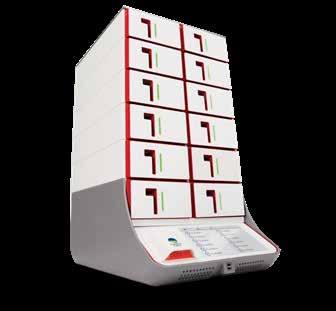
From Abbott
The ImmTox270 benchtop analyzer offers comprehensive toxicology screening solutions for physician offices, treatment centers and independent laboratories.
Broad test menu with over 20 assays to choose from including 14 that are now available as moderately complex.
With complete laboratory solutions from consultation to licensure, and compliance the Abbott Clinical Laboratory Solutions team has you covered.
View Brochures, Videos & More at POR.io Enter Number 2132 in the Search Area
2132
2133
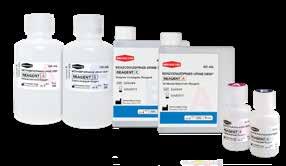
From Abbott
Prescription drug misuse and illicit drug abuse is a growing public health challenge in this country. Building a test profile that covers highly misused drugs has never been so vital. With over 20 relevant assays to choose from Abbott’s suite of Immunalysis reagents allows you to easily screen for relevant substances. Our complete line of assays, calibrators, and controls enables you to implement an efficient drug screening program in office.
View Brochures, Videos & More at POR.io Enter Number 2133 in the Search Area


For those who say “the grass isn’t always greener on the other side” my reply would have to be you haven’t been to Carton House in Maynooth Ireland. From what I have seen on my recent stay there, the grass definitely appears greener both literally and figuratively.

This 5-star, luxury Fairmont run hotel, the only Fairmont in Ireland and the oldest in its collection of hotels is just impressive in every way. Carton House was named one of the world’s best 42 hotels by the National Geographic Hotel Awards in August 2022. You are going to enter this grand resort which is a crown jewel of the capital city and local county and understand why. Located 20 minutes outside of Dublin, in the county of Kildare, Carton House has a history that spans over 8 centuries. Most of that time it was owned by the Fitzgerald family starting in 1176 until the 1920’s when the son of the 6th Duke sold his birthright to pay off an immense gambling debt. The history is so deep and interesting here my meagre word count limit cannot do it justice. The name ‘Carton’ is old Irish name ‘Baile an Carithe’ translated to Land of the Pillar Stone. There is no shortage of stone on this prop erty with its 5.5 miles of fully walled estate turned resort. It has hosted Queen Victoria, Princess Grace and Prince Rainer to name of few famous past inhabitants. While the history is amazing, its transition to modern-day full-ser vice luxury resort is what I am hoping will inspire you to visit. And the history here will then speak for itself.
Carton House first opened as a hotel in 2002. It was sold in 2017 and has been part of a multi-million-dollar renovation and restoration inside and out. Once you pass through the entrance and are surrounded by 1,100 acres of conservation parkland which sits on the River Rye you will not be able to know where to look first. There are golf courses, ponds, bridges, and ancient woodlands with some of the oldest trees you probably have ever seen all calling to be looked at. And you haven’t even gotten to the hotel yet. When you see the hotel, it is like something out of a European storybook. It is a fairytale country manor house. It is massive, awe inspiring, jaw dropping beautiful and I still cannot believe it was a home to actual people who lived there.
Once you pull up to the front doors by way of a circular stone drive, you are greeted by an old Irish taxi loaded up with vintage bags for you to see. The first of so many visual treats here. The doormen are kind and make your first greeting perfect for after a flight over. The lobby is serene and lovely. Stunning flowers, comfy sofas and chairs are there to be used. You won’t see big welcome desks and signs around. It’s as if you have walked into someone’s beautiful parlor and are being greeted by friends to sit and relax. It puts you at ease and ready to immerse yourself in the true Irish country manor resort experience. There are two desks with warm and attentive individuals waiting to check you in and see to your every need. The morning we arrived (very early) our room was not ready and we were quickly checked in to an available
room to shower, change, sleep or relax until our room was available. Just past the desk area of the lobby sits one of the hotels 4 restaurants, Kathleen’s Kitchen and the Courtyard Bar. More on those to come.
The resort has 169 luxury guestrooms. If you were to stay in the “newer” and “newly” renovated The Garden Wing of the hotel you would access it through glass lined walls overlooking the grounds from the lobby. These rooms have all modern amenities and many have balconies or patios to bring the views of the surrounding gardens, walking trails, golf courses and woodlands right to your room. This wing also hosts the award-winning spa and indoor pool. If a travel back in time guestroom is what you are wanting, then you must stay in The House section of the hotel that dates back to 1739. Located off the other side of the lobby and in the actual part that was the Palladian style mansion is a treat. Just walking to get to your room you are treated to history everywhere in the rooms you walk through, the art and accessories, the cir cular staircase that now hosts an elevator in the middle. If you want to walk you can travel up stone stairs with treads worn down by over 500 years of people walking up and down them. This section has 18 staterooms and
suites that have been thoughtfully restored to maintain the Victorian features and each room is unique with its own charm and character. These rooms feature spacious living areas with classic furnishings, custom made beds, fabulous ornate wallpaper, and art that showcases and highlights that specific period in time. They also have all the modern amenities such as huge soaking tubs and showers to make relaxing in these custom rooms not hard at all. Whichever accommodation you choose it will not disappoint.
After all that laying around it’s time to get outside and explore this walled wonderland. Let’s talk golf. Ok conversation over. I know nothing about golf. Can’t even hit a mini golf ball. And don’t want to but I was lucky to have my husband John with me and he plays golf. He was lucky enough to golf with our new friend Des, a friend of a friend and golf member at Carton House. It has hosted the Irish Open three times, the World Amateur Team Championship in 2018 and many international tournaments throughout the years. There is not one but two championship golf courses here. The O’Meara and Montgomerie courses. They have also been renovated and refreshed since 2017. I will quote my husband saying the courses are “challenging” and “full of deep bunkers.” I translate that into I think he’s not that great at golf and got a lot of balls in the sand traps. Not to worry because if you are looking to sharpen or improve your golf beyond the two amazing courses here you can attend private lessons, clinics or have on- course tutorials from the Golf Ireland Academy also located on the grounds of the resort. The academy has private tee ing areas, all sorts of high-tech golf stuff I know nothing about (I don’t want to lie to my readers!) and PGA pro
fessionals looking to make your golf dreams and your skill set even better. There is also a pro shop filled with all the gear a golfer could wish for and locker rooms. If you don’t golf, don’t worry, there is still plenty to do. The resort has bicycles for riding the many trails, woods and gardens. There are also walking trails and one that is paved and will take you right into the university village of Maynooth with its restaurants and pubs just a 15-minute walk from the resort. Tennis? They have many courts. You want to learn falconry? Who doesn’t? They have that. Archery? They have that too. You can take canoe, fishing, kayaking and boating excursions off of the Rye Water and see all of the conservation wildlife that is abundant all over the grounds. Like picnics? I do. Only with champagne. Luckily you can choose one of the many scenic areas available and they will have a pic nic especially made for you. Take the time to try one of these and many other unique activities at Carton House to make your stay even more memorable. Now if you like to be pampered then they have you covered. The Carton House has a luxury spa waiting to treat you to specialized facial and body treatments such as massages, seasonal treatments and facial packages to help you feel as good as you will look. A gym is stocked with cardio and strength equipment so you won’t miss a workout. There is a relaxation room and 18-meter pool to use as well. The skilled staff will make sure your experience is top notch.
Now you definitely need to eat (and drink) after all those activities. You will not go hungry or thirsty at The Carton House. Must try dining experiences here are plenty. The morning breakfast in The House is amazing. Overlooking

the courtyard boasting the Rose Garden, designed by Lady Emily to hide her children while they were playing, you will be served an array of fresh pastries, breads and fruits as well as fresh juices, hot teas and beverages. The menu serves traditional and contemporary hot breakfast entrées to start your day in the best way. Gluten free like me? Not to worry, they have many delicious options that you will not feel like you are missing out at all. Do you want to skip breakfast and go right to afternoon tea? You should because then you can have champagne (although it’s never too early for cham pagne). Every space to have tea here is amazing but I say have it in the gold salon. You will feel like the aristocrats that used to enjoy the same pastime here. Absolutely breathtak ing from the floor to the ceiling it is an unforgettable treat of the finest teas, China cups, scones, traditional bites and pastries. Do not forget the champagne!!! If fine dining is on your must do list you don’t have to walk more than a few steps out to the Morrison Room. It is a destination in the Dublin area. To eat in this grand and stunning dining room will be a memorable occasion. The 7-course tasting menu with a defined French flair lets you experience all the best local offerings of Kildare County and the region. A must is the local cheese with honey produced on the resort from the resident bees and beekeeper. The honey alone is worth the experience. For more casual dining Kathleen’s Kitchen locat ed off the lobby in what used to be the servants’ kitchens and was the heart of the manor home offers lunch and dinner daily and has an open kitchen concept featuring local Irish cheeses, oysters and casual but still amazing fare. The Court yard Bar is also located outside Kathleen’s Kitchen and serves light bites and craft cocktails. You can enjoy a morning coffee here and a martini at night. The glass walls overlooking an outdoor courtyard and gardens has comfy chairs, couches

and lighting to keep you going from day until night. The service is warm and friendly to you feel happy to kick back and unwind. If you are willing to travel outside of The House section of the hotel and walk across a small walled courtyard you will get to the Carriage House. This is a sophisticated gastropub was an actual carriage lodge to the Fitzgerald family. It offers a true Irish hello as you walk in. Especially popular with golfers and guests alike you can relax, socialize and eat some seriously good food while in this cozy site. I spent a good amount of time here enjoying the amazing veg etarian soups, seafood chowder, Caesar salad, chicken tikki masala and the Kilmore Black Sole to name a few. You obvi ously must have a fresh tapped Guinness while sitting at the bar. I didn’t but my husband sure did and I was introduced to the baby Guinness. Not a Guinness at all. Make sure you try one. Two places I did not get to experience because they are reserved for advanced booking but looked amazing were The Duke’s rest located off the lobby in the old game hanging room. This venue is exclusively for wine tasting. Also, The Whiskey Library. Need I say more? All things whiskey sipped in an exclusive library setting.
My stay at Carton House felt too way too short. It’s relax ing and beautiful surroundings left me thinking I need to stay longer to explore more of this elegant retreat and all that Ireland has to offer. I loved every minute of enjoying the warm Irish welcomes and smiles and generous hospi tality. There’s an Irish proverb that says, “The best things in life are the people we love, the places we have been and the memories we have made along the way.” I hope you can come here to this place and make memories with the people you love.
2137
The OSOM® BVBLUE® detects elevated vaginal fluid sialidase activity, an enzyme produced by bacterial pathogens associated with bacterial vaginosis including Gardnerella, Bacteroides, Prevotella and Mobiluncus. OSOM® BVBLUE® is more sensitive than Amsel criteria providing physicians with a more accurate diagnosis to treat and minimize serious health consequences such as early spontaneous preterm births and miscarriage.
View Brochures, Videos & More at POR.io Enter Number 2137 in the Search Area
The OSOM® Trichomonas Rapid Test is intended for the qualitative detection of Trichomonas vaginalis antigens from vaginal swabs or from the saline solution. The OSOM® Trichomonas Rapid Test is a CLIA-waived rapid test available today. OSOM® Trichomonas is more sensitive than wet mount due to the assay being able to detect viable and non-viable organisms which offers significant benefits to the patient and clinician alike.
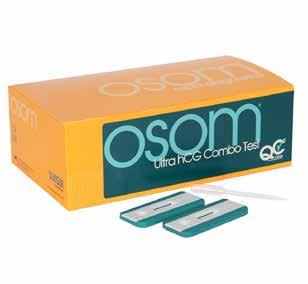

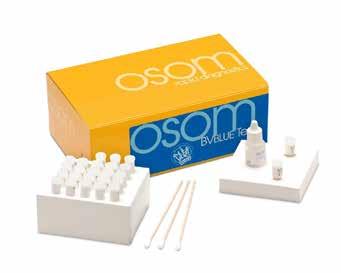
View Brochures, Videos & More at POR.io Enter Number 2138 in the Search Area
The OSOM® Ultra hCG Combo test is a simple immunoassay for the qualitative detection of human chorionic gonadotropin (hCG) in serum or urine for the early confirmation of pregnancy. Internal studies have confirmed that the OSOM® Ultra hCG Combo test does not have a false negative result from hCG variants providing physicians with a higher level of confidence.
View Brochures, Videos & More at POR.io Enter Number 2139 in the Search Area


